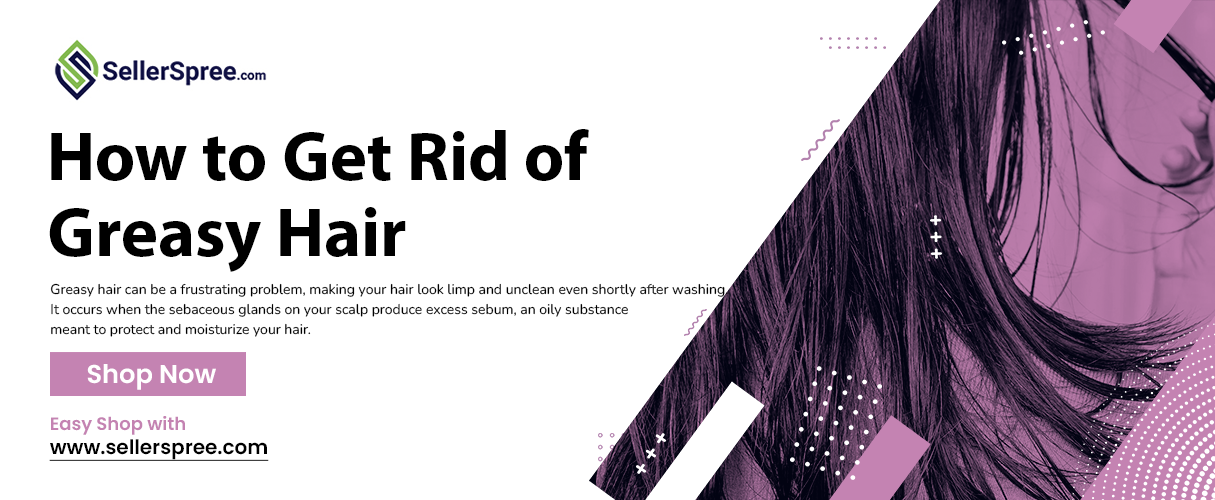
Shop Now: https://www.sellerspree.com
Greasy hair can be a frustrating problem, making your hair look limp and unclean even shortly after washing. It occurs when the sebaceous glands on your scalp produce excess sebum, an oily substance meant to protect and moisturize your hair. Fortunately, there are several strategies you can employ to manage and reduce greasiness, leaving your hair looking fresh and clean. Here’s a comprehensive guide on how to get rid of greasy hair.
Understanding the Causes of Greasy Hair:
Before diving into the solutions, it’s important to understand what causes greasy hair. Some common factors include:
- Genetics: Your genetic makeup can influence how much oil your scalp produces.
- Overwashing: Washing your hair too frequently can strip away natural oils, prompting your scalp to produce more sebum to compensate.
- Hormonal Changes: Hormonal fluctuations, such as those occurring during puberty, menstruation, or pregnancy, can increase sebum production.
- Hair Products: Using the wrong hair products or applying them incorrectly can contribute to greasiness.
- Diet and Lifestyle: A diet high in fatty foods, stress, and lack of sleep can also impact sebum production.
Effective Strategies to Combat Greasy Hair:
Wash Less Frequently:
While it might seem counterintuitive, washing your hair less often can help regulate oil production. Overwashing can strip your scalp of natural oils, causing it to produce even more sebum. Try washing your hair every two to three days instead of daily. Gradually, your scalp will adjust and produce less oil.
Use the Right Shampoo and Conditioner:
Choose a shampoo specifically designed for oily hair. Look for labels that mention “clarifying,” “volumizing,” or “balancing.” Avoid shampoos that are too moisturizing or hydrating, as they can weigh down your hair and make it appear greasier.
When using conditioner, apply it only to the ends of your hair rather than the roots. This helps to avoid adding unnecessary moisture to your scalp, which can exacerbate oiliness.
Rinse Thoroughly:
Ensure you rinse your hair thoroughly after shampooing and conditioning. Any residue left behind can attract dirt and oil, making your hair greasy faster. Spend an extra minute or two under the shower to make sure all product is washed out.
Use Dry Shampoo:
Dry shampoo is a quick and effective way to absorb excess oil and refresh your hair between washes. It can add volume and make your hair look cleaner. Apply dry shampoo to the roots, let it sit for a few minutes, then brush it out. Be careful not to overuse it, as too much product buildup can cause scalp issues.
Avoid Touching Your Hair:
Touching your hair frequently can transfer oils from your hands to your hair, making it greasy. Try to avoid running your fingers through your hair or brushing it excessively throughout the day.
Adjust Your Diet:
A healthy diet can have a positive impact on sebum production. Incorporate more fruits, vegetables, and lean proteins into your meals, and reduce your intake of greasy, fatty foods. Drinking plenty of water can also help keep your scalp and hair hydrated without excess oil.
Manage Stress:
Stress can trigger hormonal changes that lead to increased oil production. Practice stress management techniques such as exercise, meditation, yoga, or hobbies that help you relax. Adequate sleep is also crucial for maintaining hormonal balance.
Use Apple Cider Vinegar:
Apple cider vinegar can help balance the pH of your scalp and remove excess oil. Mix one part apple cider vinegar with two parts water, and use it as a rinse after shampooing. Leave it on for a few minutes before rinsing thoroughly with water. Use this treatment once a week.
Try Tea Tree Oil:
Tea tree oil has natural antibacterial and anti-inflammatory properties that can help control oil production and keep your scalp healthy. Add a few drops of tea tree oil to your shampoo or mix it with a carrier oil like coconut oil and apply it to your scalp before washing your hair.
Opt for Lightweight Styling Products:
Heavy styling products can weigh down your hair and make it appear greasy. Choose lightweight products that add volume and texture without leaving a heavy residue. Use them sparingly and avoid applying them to your roots.
Conclusion
Greasy hair can be managed effectively with the right approach and products. By understanding the causes of excess oil production and adopting suitable hair care practices, you can keep your hair looking fresh and clean. Remember, it may take some time for your scalp to adjust to new habits, so be patient and consistent with these strategies. With the right care, you can enjoy healthy, beautiful hair without the greasiness.
Tags: Greasy Hair, Oily Hair, Rid of Greasy Hair, Greasy Hair Tips, SellerSpree, Hair Health, Hair Care Routine, Dry Hair Solutions, Healthy Hair Routine, Hair Treatment, Moisturized Hair, Frizz Free, Beauty Tips, Hair Love, Glowing Hair, Hydrated Hair, Hair Products, Hair Tips for Women, Hair Care Products, Permanent Hair Color, Hair Shampoo, Hair Color, Beauty Products, Beauty Supplies, Salon Supplies, Cosmetologist Supplies, Cosmetics, Hairspray, Creams, Moisturizer, Serum, USA, Canada, Sell on Amazon, Sell on Ebay, Sell on Walmart
